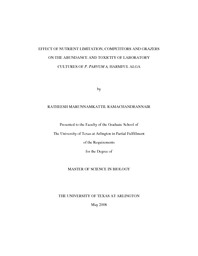
ATTENTION: The works hosted here are being migrated to a new repository that will consolidate resources, improve discoverability, and better show UTA's research impact on the global community. We will update authors as the migration progresses. Please see MavMatrix for more information.
Show simple item record
| dc.contributor.author | Marunnamkattil Ramachandrannair, Ratheesh | en_US |
| dc.date.accessioned | 2008-08-08T02:31:06Z | |
| dc.date.available | 2008-08-08T02:31:06Z | |
| dc.date.issued | 2008-08-08T02:31:06Z | |
| dc.date.submitted | February 2008 | en_US |
| dc.identifier.other | DISS-1998 | en_US |
| dc.identifier.uri | http://hdl.handle.net/10106/914 | |
| dc.description.abstract | P. parvum Carter is a haptophyte that occurs world wide in both fresh and brackish waters. Though P. parvum blooms occur world wide under a variety of environmental conditions, it occurs during the cooler months of the year in Texas. Various treatment combinations of temperatures, salinity and limiting nutrients were used to test the hypothesis that the interaction of these factors would affect the abundance and toxicity of P. parvum. In addition to testing various above mentioned factors and their interactions, P. parvum was grown in mixed species cultures with major competitors from a natural lake community (Lake Whitney) to test the hypothesis that competition from other algal species could be partially responsible for the seasonal dynamics of P. parvum blooms in Texas lakes. Furthermore, the mortality rate of P. parvum was studied in a preliminary grazing experiment using two cladoceran species.
Findings confirm earlier reports of increase in toxicity during nutrient limiting growth conditions. P. parvum batch cultures grown at 3 psu salinity were more toxic than those cultures grown at 1 psu salinity and there was a considerable increase in acute fish toxicity during P limitation rather than in N limitation. A substantial decrease in toxicity was noticed in mixed species cultures, especially those grown at 30 0C.
It has been found that competition from other algal species can explain at least in part, the seasonal dynamics of P. parvum blooms in Texas lakes. P. parvum abundance was greater in mixed species cultures at 10 0C (representing winter conditions) than the corresponding cultures at 30 0C. At warmer temperatures (30 0C representing summer conditions) other algal species out-competed P. parvum.
Sub-lethal toxicity studies confirm the toxic effects of P. parvum on Daphnia magna, a common grazer species that cooccurs with P. parvum in some habitats. Mortality rate of P. parvum under the influence of grazers was studied using a dilution experiment with two cladoceran species Daphnia magna and Ceriodaphnia dubia. This study demonstrated that cladocerans cause mortality of P. parvum suggesting that direct ingestion may be one route by which grazing zooplankton are exposed to toxins. | en_US |
| dc.description.sponsorship | Grover, James P. | en_US |
| dc.language.iso | EN | en_US |
| dc.publisher | Biology | en_US |
| dc.title | Effects Of Nutrient Limitation, Competitors And Grazers On The Abundance And Toxicity Of Laboratory Cultures Of P. parvum, a Harmful Alga | en_US |
| dc.type | M.S. | en_US |
| dc.contributor.committeeChair | Grover, James P. | en_US |
| dc.degree.department | Biology | en_US |
| dc.degree.discipline | Biology | en_US |
| dc.degree.grantor | University of Texas at Arlington | en_US |
| dc.degree.level | masters | en_US |
| dc.degree.name | M.S. | en_US |
| dc.identifier.externalLink | https://www.uta.edu/ra/real/editprofile.php?onlyview=1&pid=20 | |
| dc.identifier.externalLinkDescription | Link to Research Profiles | |
Files in this item
- Name:
- umi-uta-1998.pdf
- Size:
- 404.9Kb
- Format:
- PDF
This item appears in the following Collection(s)
Show simple item record


